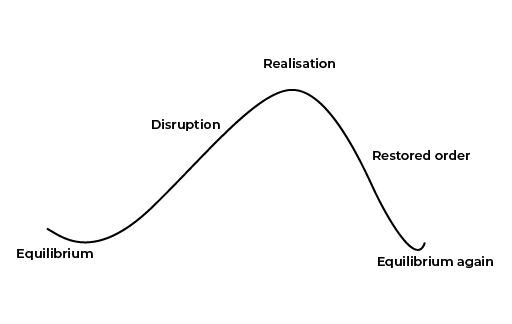2.1 Narrative arcs
Todorov (1969) identified a common narrative arc that can help us consider the possible stories that the image you selected for your free writing might tell you about an issue or an area of interest in your own practice.
There are five stages of the narrative:
- Equilibrium exists at the start of the story – this is the ‘steady state’ where things are all as they should be.
- Disruption occurs when an action or a character disrupts the equilibrium and creates a problem.
- Realisation occurs when the characters acknowledge the problem and undertake a quest to solve it. The narrative builds to a climax.
- Restored order develops as the damage is gradually repaired and the problem solved.
- Equilibrium again occurs when the problem is fully solved and some form of (new) reality is possible.
Activity 2 Searching for narrative arcs
Return to your free writing and the image and begin to search for a narrative arc. What is the story of the image – where does it begin, what are the key incidents, who are the important characters? You might find your narrative arc within your free writing, or you may want to return to the image and consider afresh the story that it tells, using your free writing as a reminder of what it was in the image that struck you and provoked a response.
Now plot your narrative using the grid below:
| Story title | |
| Equilibrium | |
| Disruption | |
| Realisation | |
| Restored order | |
| Equilibrium again |
When you have completed the grid, spend a few moments reflecting:
- What are the key moments?
- Are there particular characters that seem central to the narrative?
- What positive steps were taken to overcome the disruption?
- Might there be more than one possible ending?
Make some notes on your responses to each of these questions.
Comment
Todorov’s (1969) narrative arc, while it may not align completely with our initial telling of a story, gives us a way to think with our writing and to begin to explore it in more depth. On the face of it, Todorov’s focus on overcoming problems within the story can be seen to go against the appreciative inquiry approach. Yet, the very challenge of bringing these stories to a place of equilibrium, the ‘push’ to resolve, to see what or who or how we can focus on resolutions, can engage us in developing positive responses to challenging issues and in imagining more than one possible ending or solution. These things are at the heart of appreciative inquiry, but we may need to play around with our initial stories a little to help us realise their potential.
In the next section, you will consider how viewing stories from different perspectives can help to generate new possibilities.

